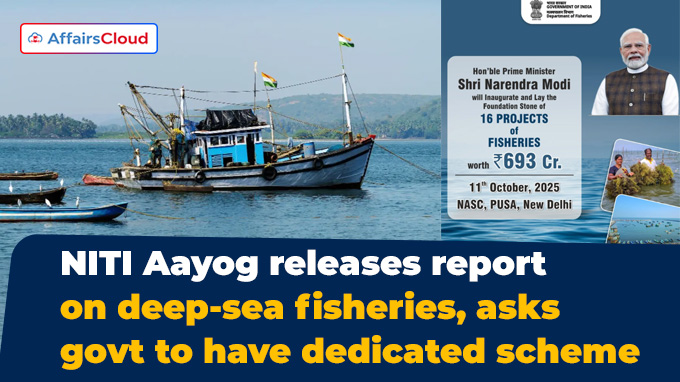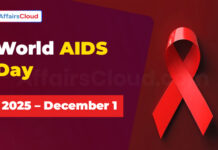In October 2025, the NITI (National Institution for Transforming India) Aayog released a report on “India’s Blue Economy: Strategy for Harnessing Deep-Sea and Offshore Fisheries” emphasising on the need of capacity building and research in this field.
- The Agriculture and Allied Sectors Division of NITI Aayog had prepared the report.
Exam Hints:
- What? India Blue Economy report released
- Who? NITI Aayog
- Title: Strategy for Harnessing Deep-Sea and Offshore Fisheries
- Fisheries Sector in India: 8% of global production, export- Rs.60,523 cr, supports 30 mn people
- Six Policy intervention: Overhauling policies and regulations, Strengthening institutional and capacity building, Modernizing fleets and upgrading infrastructure, Sustainable fisheries management, Mobilizing resources and financing, Fostering stakeholder inclusion and partnerships.
- Three Phases: Laying the foundation and fostering early growth (Rs.2430 cr), Scaling up and achieving global competitiveness (Rs.4210 cr), Global leadership in sustainable deep-sea fisheries (Rs.1690 cr)
Key Highlights
Key People: The report was formally launched by Prof. Ramesh Chand, Member (Agriculture), NITI Aayog, and B.V.R. Subrahmanyam, CEO (Chief Executive Officer), NITI Aayog.
- Along with the report, a detailed presentation on the report was made by Dr. Neelam Patel, Programme Director, NITI Aayog.
India’s Fisheries sector: India is the second-largest fish-producing country in the world, accounting for 8% of global production.
- India’s export earnings from fish and fishery products doubled to Rs. 60,523 crore (cr) in Financial Year 2023-24 (FY24) from Rs. 30,213 cr in 2013-14.
- This sector supports the livelihoods of around 30 million (mn) people.
Exclusive Economic Zone (EEZ): The deep waters beyond the continental shelf, extending beyond the EEZ boundary of 200 nautical miles (nmi), contain select high-value fish stocks.
- The report presents a comprehensive framework covering the deep-sea fishing sector within India’s EEZ and international waters accessed through regional fisheries agreements.
- This framework adopts a science-based, technology-enabled, socially inclusive, and ecologically sustainable approach to harnessing India’s deep-sea fisheries potential.
Policy Interventions
The report identifies the following six key policy interventions:
Overhauling policies and regulations: Create clear rules to help everyone fish responsibly in deep waters and a Regulatory Act with a legal framework aligned to international laws (United Nations Convention on the Law of the Sea (UNCLOS)) standards, and guidelines.
Strengthening institutional and capacity building: Creation of a dedicated agency/directorate under the Department of Fisheries for holistic governance.
Modernizing fleets and upgrading infrastructure: Incentivize the adoption of larger and modernizing existing deep-sea vessels equipped with modern refrigeration systems and value-addition facilities.
Sustainable fisheries management: Operationalize marine spatial planning and designate deep-sea marine protected areas based on scientific assessments.
Mobilizing resources and financing: Establish a dedicated Deep-Sea Fishing Development Fund (DSFDF) through budgetary support under PMMSY (Pradhan Mantri Matsya Sampada Yojana) and industry contributions.
Fostering stakeholder inclusion and partnerships: Develop co-management frameworks incorporating community institutions, fish worker unions and industry bodies.
Three Phases
An indicative costing framework for the three phases has also been provided by considering the convergence of centrally sponsored and central sector schemes related to fisheries:
Phase 1-Laying the foundation and fostering early growth: This on laying a
solid foundation for the growth and development of India’s deep-sea fishing sector through short-term interventions (3 years – 2025-28).
- The total estimated cost for Phase 1 is Rs. 2430 cr.
Phase 2-Scaling up and achieving global competitiveness: This phase is implemented through medium-term interventions for 4 years, 2029-32.
- The total estimated cost for Phase 2 is Rs. 4210 cr.
Phase 3-Global leadership in sustainable deep-sea fisheries: The long-term interventions (8 years and beyond – 2033 onwards) would be geared towards consolidating the gains made through phases 1 and 2, ensuring long-term sustainability, and positioning India as a global leader in sustainable deep-sea and offshore fishing practices.
- The total estimated cost for Phase 3 is Rs. 1690 cr.
Sustainable Development Goals (SDG) aligned approach
SDG 14: Although SDG 14 — Life Below Water — is most directly pertinent, the expansion of the deep-sea and offshore sector exerts multidimensional influences that advance several other SDGs.
- These include poverty reduction (SDG 1), zero hunger (SDG 2), decent work and economic growth (SDG 8), responsible consumption and production (SDG 12), and climate action (SDG 13).
Challenges
While India’s deep-sea and offshore fishing sector holds immense potential, it faces following challenges that have hindered its growth and development.
- Stock assessment challenges
- Infrastructure and Technology Gaps
- High Operational Costs
- Financing, Insurance, and Capital Access
- Sustainability and Conservation Concerns
About National Institution for Transforming India (NITI) Aayog:
Chairman – Prime Minister (PM) of India (Currently Narendra Modi)
Vice Chairperson – Sumant K Bery
Headquarters – New Delhi, Delhi
Establishment – 2015





